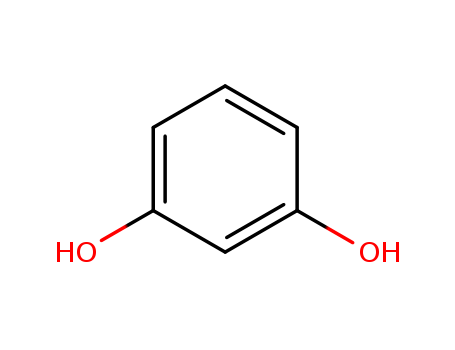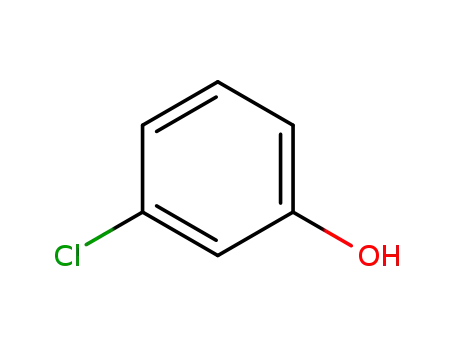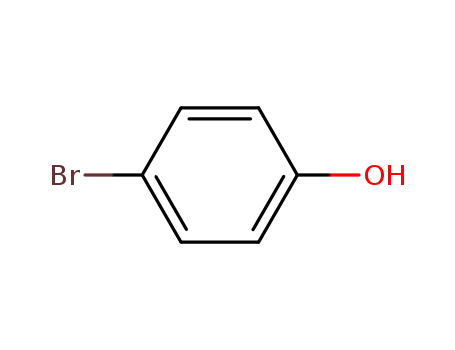Your Location:Home > Products > Other > Resorcinol



CasNo: 108-46-3
MF: C6H6O2
Appearance: crystals or powder
|
description |
Resorcinol has bactericidal, fungicidal and anti-itching effect with the bactericidal effect being 1/3 of the phenol and also a low irritating and corrosive property. At low concentration, it can play the role promoting the regeneration of horny while having keratin exfoliation effect at high concentration. It is mainly used for rubber adhesives, plastics, synthetic resins, synthetic fibers, dyes, preservatives, anti-itch, anti-fungal agent, analytical reagent and can also be used to treat ringworm, eczema, seborrheic dermatitis, acne and psoriasis. Figure 1 3D structure of resorcinol. The above information is edited by the lookchem of Dai Xiongfeng. |
|
reaction |
The chemical property of resorcinol is active and it can participate in the following four kinds of reaction. (1) It can have reaction with sodium amalgam, water for production of dihydro-resorcinol (1, 3-cyclohexanedione). (2) It can generate ester with reaction with acid anhydride. (3) It can react with hydroxylamine in a diketone type to generate oxime. (4) In the action of concentrated sulfuric acid or zinc chloride, it can react with phthalic anhydride to generate fluorescent dye-fluorescent yellow. |
|
Indications |
It can be used for the treatment of seborrheic dermatitis, acne, superficial skin fungal infections, tinea versicolor, calluses, corns, and common warts. |
|
Side effects |
1, it can cause contact dermatitis and has weak irritation effect on skin and mucous membrane. This product, when being absorbed through broken skin and wound surface in the large amount, can lead to myxedema. 2, because this product can be absorbed through the skin or ulcers, and thus is not suitable or being applied to infants and young children in high concentration and large-scale. 3, poisoning symptoms include diarrhea, nausea, vomiting, stomach pain, dizziness, severe or persistent headache, fatigue or weakness, being prone to excitement or irritability, sleepiness, sweating, bradycardia, and shortness of breath. 4, applying this product to the wound of children can lead to methaemoglobinaemia. 5, since this product has anti-thyroid effects, systemic effects is similar as phenol poisoning, but often accompanied with convulsions. |
|
Precautions |
1, it can turn pale hair to black color; it can cause skin redness and scaling at a few days after treatment; take this drug with caution. 2, dark-skinned patients may be caused by its stimulation of pigment generation. 3, when being used in combination with soaps, cleansers, acne preparations, preparations containing alcohol or acid-dimensional A, it can cause skin irritation or excessive drying effect. 4, it has anti-thyroid effects; it can lead to myxedema upon long term use (especially used in ulcer surface). 5. This product is toxic and thus this product can’t subject to systemic or long-term use; avoid applying it to the broken skin wound in order to preventing poisoning. |
|
Applications |
Resorcinol is an important raw material for organic synthesis. It is mainly used as the raw material of rubber adhesives, raw analysis reagents, drugs and preservatives, dyes, synthetic resin. For example, eosin is an important triphenylmethane dye with red dying which is mainly used for yarn dyeing. It is made from the following process: first generate its intermediate fluorescent yellow thorough the co-heating between resorcinol and phthalic anhydride in the presence of zinc chloride or concentrated sulfuric acid, then apply tetra-bromination to generate it. Eosin is commonly used to produce red ink, also be used as biological material such as the staining agent for microscopic examination. If the intermediate fluorescent yellow is subject to bromination in acetic acid solution, only di-bromination can occur; further co-heating with mercuric acetate can obtain mercurochrome (also known as red mercury bromine) which is an important antiseptic disinfectant. It is easily soluble in water with its 2% aqueous solution being the daily-used “red syrup” for disinfection. The alcohol and acetone solution of mercurochrome may also be used for skin disinfection. Put resorcinol and hexanoic acid for acylation reaction and further reduction can generate 4-n-hexyl hydroquinone which is also a kind of disinfectant. In medicine, it is also used as a topical anti-itch agent and a digestive agent of the intestinal tract. |
|
Toxicity |
GRAS (FEMA). |
|
Production |
1. Benzene sulfonic acid is sulfonated with oleum; further go through neutralization, alkaline melting, acidification, n-butanol extraction, evaporation of the solvent, and distillation to obtain the finished products. 2. It can be produced through the hydrogenation of m-dinitrobenzene into m-phenylenediamine which is further subject to hydrolysis to get the finished product. 3. It can be produced from the hydrolysis of m-aminophenol. Resorcinol can also derived from benzene and propylene using peroxide di-isopropylbenzene method with the process being similar as isopropylbenzene production. Put benzene, 65% fuming sulfuric acid and sodium sulfate separately into the reactor; control the reaction temperature at 75 ℃ to obtain the sulphonate. Then add anhydrous sodium sulfate to this sulphonate, stir and heat to 175 ℃ for dissolving it; Add sulfur trioxide at this temperature and continue the reaction for an additional 1.5h to generate di-sulphonate (with the content of benzene disulfonic acid being 75%). Use dilute alkali to neutralize the di-sulphonate and remove the excess amount of sulfate salt; the resulting sodium benzene di-sulfonate is gradually added into the molten sodium hydroxide 290 °C; raise the temperature to 325 °C within 15min and further dissolve the alkali melting substance in water; acidify it with sulfuric acid and extract with ether; evaporate the solvent to obtain the finished resorcinol products. |
|
Definition |
ChEBI: A benzenediol that is benzene dihydroxylated at positions 1 and 3. |
|
Aroma threshold values |
Detection: 6 to 40 ppm |
|
Synthesis Reference(s) |
Tetrahedron Letters, 35, p. 8727, 1994 DOI: 10.1016/S0040-4039(00)78482-6 |
|
General Description |
Very white crystalline solid that becomes pink on exposure to light if not completely pure. Burns although ignition is difficult. Density approximately 1.28 g / cm3. Irritating to skin and eyes. Toxic by skin absorption. Used to make plastics and pharmaceuticals. |
|
Air & Water Reactions |
Hygroscopic. Soluble in water. |
|
Reactivity Profile |
Resorcine is a weak organic acid. Incompatible with acetanilide, albumin, alkalis, antipyrine, camphor, iron salts, menthol, spirit nitrous ether, and urethane. Can react with oxidizing materials . Has a potentially explosive reaction with concentrated nitric acid [Lewis]. Turns pink on contact with iron. |
|
Hazard |
Irritant to skin and eyes. Questionable car- cinogen. |
|
Health Hazard |
Inhalation of vapors or dust causes irritation of respiratory tract. Ingestion causes burns of mucous membranes, severe diarrhea, pallor, sweating, weakness, headache, dizziness, tinnitus, shock, and severe convulsions; may also cause siderosis of the spleen and tubular injury to the kidney. Contact with eyes causes irritation. Can be absorbed from wounds or through unbroken skin, producing severe dermatitis, methemoglobinemia, cyanosis, convulsions, tachycardia, dyspnea, and death. |
|
Fire Hazard |
Behavior in Fire: Containers may explode. |
|
Flammability and Explosibility |
Nonflammable |
|
Contact allergens |
Resorcinol is used in hairdressing as a modifier (or a coupler) of the PPD group of dyes. It is the least frequent sensitizer in hairdressers. It is also used in resins, in skin treatment mixtures, and for tanning. Severe cases of dermatitis due to resorcinol contained in wart preparations have been reported. |
|
Biochem/physiol Actions |
Resorcinol is an aromatic alcohol serves as an antiseptic. It reduces pain from painful nodules in patients suffering from Hidradenitis suppurativa (HS). |
|
Safety Profile |
Human poison by ingestion. Experimental poison by ingestion, intraperitoneal, parenteral, and subcutaneous routes. Moderately toxic experimentally by skin contact and intravenous routes. Questionable carcinogen with experimental tumorigenic data. Human mutation data reported. A skin and severe eye irritant. It can cause systemic poisoning by acting as both a blood and nerve poison. In a suitable solvent, this material can readily be absorbed through human skin and can cause local hyperemia, itching, dermatitis, edema, and corrosion associated with enlargement of regonal lymph glands as well as serious systemic disorders such as restlessness, methemoglobinemia, cyanosis, convulsions, tachycardia, dyspnea, and death. These same symptoms can be induced by ingestion of the material. For poisoning, treat symptomatically. Get medical advice. Used as a topical antiseptic and keratolytic agent. Combustible when exposed to heat or flame; can react with oxidming materials. To fight fEe, use water, CO2, dry chemical. Potentially explosive reaction with concentrated nitric acid. Incompatible with acetadde, alkalies, ferric salts, spirit nitrous ether, urethan. When heated to decomposition it emits acrid smoke and irritating fumes |
|
Potential Exposure |
Resorcinol is weakly antiseptic; resorcinol compounds are used in the production of resorcinol-formaldehyde adhesives; or as an intermediate; in pharmaceuticals and hair dyes for human use. Major industrial uses are as adhesives in rubber products and tires, wood adhesive resins, and as ultraviolet absorbers in polyolefin plastics. Resorcinol is also a by-product of coal conversion and is a component of cigarette smoke. Thus, substantial opportunity exists for human exposure. |
|
Carcinogenicity |
Acute Toxicity. The primary signs of intoxication resemble those induced by phenol, and include initial stimulation of the CNS, followed by depression, renal glomerular and tubular degeneration, central hepatic necrosis, myocardial depression, pruritus, and reddening of the skin. Resorcinol has been reported to be less toxic than phenol or pyrocatechol by oral and dermal routes. Resorcinol is a simple aromatic chemical (1,3-benzenediol) that has found widespread use, particularly as a coupler in hair dyes. Clinical experience clearly shows that resorcinol is a skin sensitizer, although several predictive tests have been negative. In a local lymph node assay performed in accordance with OECD Guideline 429, resorcinol was identified as a skin sensitizer. Few reports of the toxicity of resorcinol have been published. Oral ingestion in humans may cause methemoglobinemia, cyanosis, and convulsions, whereas dermal exposure has been reported to cause dermatitis, hyperemia, and pruritus. Industrial inhalation exposures are rather rare, but could occur in any industry if the compound is heated beyond 300°F. Pathology reported for humans includes anemia, marked siderosis of the spleen and marked tubular injury in the kidney, fatty changes of the liver, degenerative changes in the kidney, fatty changes of the heart muscle, moderate enlargement and pigmentation of the spleen, and edema and emphysema of the lungs. |
|
Shipping |
UN2876 Resorcinol, Hazard Class: 6.1; Labels: 6.1-Poisonous materials. |
|
Purification Methods |
Crystallise resorcinol from *benzene, toluene or *benzene/diethyl ether. The benzoate has m 117o. [Beilstein 6 IV 2069.] |
|
Incompatibilities |
Reacts with oxidizers, nitric acid; oil, ferric salts; methanol, acetanilide, albumin, antipyrene, alkalies, urethane, ammonia, amino compounds. Hygroscopic; absorbs moisture from the air. |
|
Waste Disposal |
Consult with environmental regulatory agencies for guidance on acceptable disposal practices. Generators of waste containing this contaminant (≥100 kg/mo) must conform with EPA regulations govern- ing storage, transportation, treatment, and waste disposal. Dissolve in a combustible solvent and incinerate. |
InChI:InChI=1/C6H6O2/c7-5-2-1-3-6(8)4-5/h1-4,7-8H
-
-
New synthetic connections have been esta...
γ-Resorcylate decarboxylase (γ-RSD) has ...
Toward the total synthesis of acremoxant...
-
The decarboxylation rates of aqueous ben...
-
-
-
A practical procedure for the cleavage o...
-
Multifunctional molecules are capable of...
Phenol is one of the worst contaminants ...
A basic bismuth(iii) nitrate photocataly...
Both the efficiency and pathways of nitr...
As shape tailoring is gaining more atten...
In the pulse radiolysis of solutions of ...
-
-
Novel forms of black TiO2 nanotubes-base...
The 3-hydroxyphenyl allyl ethers (1a-d) ...
Raney Ni-Al alloy in a dilute aqueous al...
Salicylic acid decarboxylase (Sdc) can p...
Utilization of renewable sugars from bio...
-
The liquid-phase oxidation of benzene to...
-
Fe-ZSM-5 and Fe2O3/ZSM-5 zeolite catalys...
-
Using eugenol and vanillin as model subs...
New methods were developed for removal o...
-
Tungsten-based bimetallic catalysts M–W/...
Nickel(II) chloride complexes with PE1CE...
-
A new protecting group, 2-(piperidine-1-...
Lignin is an abundant source of aromatic...
A stable Ni2+substituted TiO2catalyst (T...
The photocatalysis of titanium dioxide (...

methyl yellow


4-amino-phenol


N,N-dimethyl-aniline


aniline


N,N-Dimethyl-4-nitroaniline


3-Dimethylaminophenol


recorcinol


phenol
| Conditions | Yield |
|---|---|
|
With ferrous(II) sulfate heptahydrate; sulfuric acid; water; dihydrogen peroxide; at 25 ℃; pH=1.8; Kinetics;
|


benzyl bromide


recorcinol
| Conditions | Yield |
|---|---|
|
With water; boron tribromide; In dichloromethane; at 20 ℃;
|

7-hydroxy-2H-chromen-2-one

3,5-dihydroxyphenol

3-monochlorophenol

4-bromo-phenol

3-(1-pyrrolidinyl)phenol

2,4,6-tris-piperidinomethyl-resorcinol

4 (4-morpholinylmethyl)-1,3-benzenediol

2,4,6-trimorpholinylmethyl-1,3-dihydroxybenzene